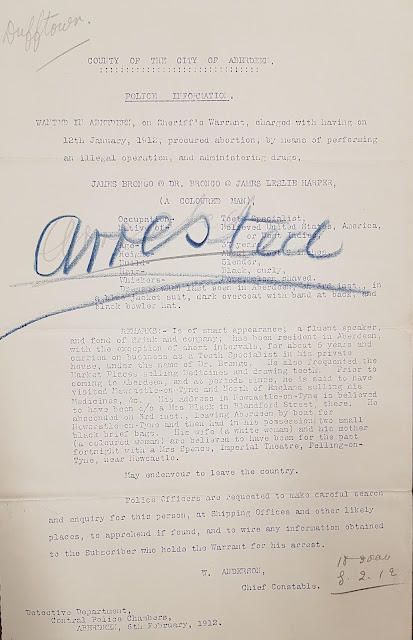Wanted: Dr Brongo
Dr Brongo had been charged with procuring abortion and he later appeared before the Justiciary Court for performing an illegal operation (how abortions were often described at the time) on a servant. Abortions were only made legal in the UK in 1967, and prior to that women with unwanted pregnancies were forced to go to backstreet abortionists, which were unregulated and could be dangerous, even deadly.
During this period, Dr Brongo would have been in a minority in Aberdeen. However, despite the offensive nature of the term “coloured” today, he was clearly a popular figure at the time. The Press and Journal reported that: “there was a large crowd […] outside the court, and when Brongo emerged, a free man, he was loudly cheered. He was seized and carried shoulder-high to his residence in Castle Street, followed by a cheering crowd, and from the windows in Castle Street women waved their hands and cloths to indicate rejoicing”.
Interestingly, Brongo’s legal counsel and the trial’s judge, Lord Ormidale, both made some reference to the race of the defendant. Newspapers reported that: “counsel for the prisoner had impressed the jury not to be prejudiced because the accused was a man of colour. He (the judge) should hope at that time of day that no Scottish jury would for a moment permit itself to be prejudiced by any such consideration.” Although the judge believed that this would not be a factor in the jury’s decision, and in fact the verdict in the case against Dr Brongo was "not proven”, clearly this was a concern for the defence.
What else do we know about Dr Brongo?
The “doctor” seems to have been quite a character: there are articles in the Press & Journal in the 1990s with people recalling having their teeth pulled by him. He was based in Aberdeen between 1910 and 1912 and in the early 1920s, and advertised himself as a teeth specialist at 41 Castle Street. He also gave lectures and offered electromagnetic therapy. Eye-wateringly, he told the Fraserburgh Herald that he had “extracted over a thousand teeth since coming to Fraserburgh and have only twice had to resort to the use of an anaesthetic”. From advertisements he seems to have toured the North East and Orkney, but it is clear he also spent time in the Newcastle area, Ulster and Yorkshire.
In an interview with the Fraserburgh Herald in 1910, Harper said that he was born in 1877 in Georgetown, British Guiana (now Guyana) and his father was a clerk in the Church of England. The poster suggests his mother lived with him and his wife and was also black. He claimed to have a degree in dental surgery but was fined in Derry, Northern Ireland, in 1917 for practising whilst not registered as a dentist.
Dr Brongo was charged with two further counts of performing illegal operations in 1922. In this instance he and co-defendants were found guilty and he was sentenced to 4 years in prison. The last trace I have been able to find of Dr Brongo in newspapers is in Barnsley, Yorkshire, in 1928, when he was in court for fraud, having sold painted butter beans as charms. In this instance, he was released.
In addition to being a fascinating glimpse into Aberdeen at the start of the 20th century, the language used on the poster is pertinent to discussions going on within the Archives, Galleries and Museums team, and the wider heritage sector, about the changes we need to make in how manage, interpret and provide access to our collections in the wake of the Black Lives Matter movement. Sources such as this provide important evidence for the lived experience of black people in the history of our region, but are unfortunately few and far between. The team is keen to ensure that our collections better reflect the racial diversity of the City and Shire, and BAME (Black, Asian and Minority Ethnic) groups feel that their stories are represented in our collections. We are also reviewing how our collections are described, as some of the contemporary terminology – as we see in this poster – is now offensive (this article: https://canadianart.ca/features/offensive-terminology-in-artwork-titles/ gives a good overview of the issues involved in an Art Gallery setting).



Comments
Post a Comment